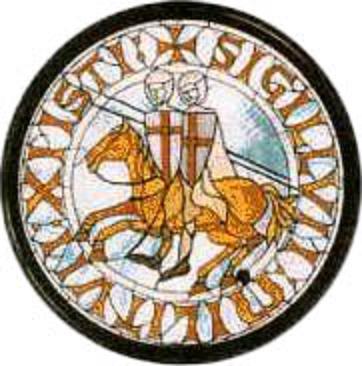The legendary Knights Templar and the dainty bluebell: an unlikely pair. However, the Knights Templar are among the research topics of which I have skimmed the surface, in writing the Blue Bells Trilogy.
Of course, the trilogy is not directly about the flower. In fact, not at all, really. The title comes from a piece of standard trombone repertoire, which in turn comes from an old folk song, and while the main characters of the trilogy are musicians, including a trombonist, the story’s medieval half focuses heavily on Scotland’s Wars of Independence, and Robert the Bruce.

To give a brief overview of the connection between Bruce and the Knights Templar, one must understand the Wars of Independence. In the late 1200′s, Edward I, ‘Longshanks,’ claimed himself overlord of Scotland, and backed that claim with the force of his much larger and better equipped army. In 1306, on being crowned King of Scots (which is a story in and of itself), Bruce was, in the words of his queen, King of the May. In other words, he was king in name only. She was correct. In truth, he was a homeless fugitive in his own realm, relying on his own people at times for food and a roof over his head; at other times, living in caves with his few men around him. The first year or so of his kingship saw his disastrous defeat in battle and the deaths of three of his four brothers, along with the deaths of many of his good friends and supporters. His wife, daughter, sister, and close friend and supporter, Isabel MacDuff, the Countess of Buchan, were taken prisoner, not to be seen again by him for eight years.
Yet Bruce continued to defy the might of England, the powerful and well-equipped Edward I, and later, his son, Edward II. With what resources did Bruce make his stand?
It has long been whispered that the legendary Knights Templar financed his war against England. Others have objected that this is unlikely, as Bruce himself outlawed the Templars in Scotland in 1309, at the Vatican’s demand. Given the frequent forcing of obedience and oaths of loyalty at the time, this does not seem, to me, to be any real conflict. Even priests and bishops were known to swear loyalty to England, under threat, and turn around and do exactly as they saw fit in working for Scotland against England. With my admittedly limited research into this area, it doesn’t seem a stretch for Bruce to make a show of doing as the Vatican requested, while continuing to work with the Templars in secret, and it would certainly be one explanation for Bruce’s rise from nothing to re-conquering his country.
Skip forward a few years to 1314, and we find ourselves at the Battle of Bannockburn, another episode in the ongoing David and Goliath story of Scotland and England. The powerful Longshanks was long since dead, and England ruled by his militarily inept son, Edward II. Despite his ineptness, Edward II still commanded an army at least three times the size of Bruce’s own. Some estimates say it was up to five times larger. There is no doubt it was better equipped. Its cavalry consisted of some 2,000 large and armored warhorses, compared to Bruce’s approximately 500 light cavalry, by which we mean unarmored horses about the size of large ponies. (Of course, Bruce used this situation to his advantage, but once again, that’s a different story. Dare we say a horse of a different color?) Stories paint a picture of Edward’s army–warhorses, foot soldiers, a huge contingent of the dreaded Welsh archers, and supply wagons–stretching some twenty miles, and shaking the earth as it passed. I think it’s a safe bet none of us in modern America have ever experienced such a force coming against us, intent on wiping us off the face of the planet.
This, however, is what Bruce and his Scots faced at Bannockburn. Edward II had been shamed and directly challenged, and he determined to defeat the Scots once and for all.
There is little controversy over how Bruce managed to face such an army, and not only survive, but completely rout such a large and powerful enemy, with relatively few losses on his own side. He arrived early. He chose his ground well, forcing England to fight in a bog, and laying that bog with murder pits and caltrops, all of which slowed and stopped much of England’s cavalry. He prepared his ground well. He thought outside the box and trained his men to take on charging cavalry in moving units of spears called schiltrons. And there is no controversy that a charge from Coxet Hill toward the end of the battle was a strong factor in Bruce’s victory.
Without going into more details as to why the battle was already going poorly for England, many experts agree that toward the end, when England was already in poor morale and disarray, somebody charged from Coxet Hill. What is argued is who. I have read three explanations. One is that it was the Islemen of the great Lord of the Isles, Angus Og, held in reserve by Bruce until they could most effectively be used. A second is that it was the townfolk, or ‘wee folk,’ as they were called, charging with makeshift banners waving on scythes, hoes, and pitchforks, determined to fight for their king–and whom England’s soldiers mistook for another, actual army. There are those who argue (and it’s a valid point) that large armies did not make a habit of running from camp followers, and camp followers did not make a habit of waving flags announcing their presence to those who could easily kill them. The third explanation is that it was the Knights Templar charging in at the critical moment, who sent Edward II fleeing the field.
In Blue Bells of Scotland, I opted for Door #2: the townfolk, the army of farmers and blacksmiths. Of course, being time travel, I added a bit to that to explain England’s terror at the charge. But I opted for this explanation as I wanted to keep the story as uncontroversially factual (yes, yes, I know it’s time travel! Apart from that!) as possible: Because the Templars, in general, and at Bannockburn in particular, are the source of much controversy.
Legends arose in Victorian times that the Templars appeared at the last minute to sway the fight in Bruce’s favor, but their presence at the battle has long been dismissed by scholars. In an article that came out after the publication of the novel, A.J. Morton, though dismissing the Victorian versions of the story, argues there is evidence they did indeed fight for Bruce. He points to 200 Templar properties in 14th Century Scotland, including 30 in Cunningham, around Ayrshire, of which Bruce himself was feudal overlord. Therefore, he says, they would have been obligated to serve Bruce, and it is ‘almost impossible’ to believe they didn’t. Michael Penman, another Bruce expert, remains skeptical, on the grounds that Templars (make that ex-Templars, as they’d been disbanded) would not fight for someone who persecuted their order.
Others, too, make strong arguments as to why the Templars didn’t, and couldn’t have, fought at Bannockburn, among them, the fact that the Templars had been disbanded long before, were being persecuted and burned throughout Europe, and any surviving Templar Knights would have been too elderly to fight by the time of Bannockburn. One interesting post taking this view can be found here.
The Templars have long been a source of fascination, and tomorrow, my guest blogger, Brendan Carroll, author of over thirty novels, who has researched them much more thoroughly than I, will be talking about them.
![]() Tweet This Post
Tweet This Post


